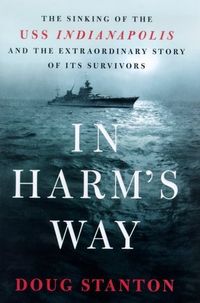
In Harm's Way: The Sinking of the U.S.S. Indianapolis and the Extraordinary Story of Its Survivors
A Nonfiction, World War II, War book. . . . the sun set . . . with guillotine-like speed...
A harrowing, adrenaline-charged account of America's worst naval disaster -- and of the heroism of the men who, against all odds, survived.On July 30, 1945, the USS Indianapolis was torpedoed in the South Pacific by a Japanese submarine. An estimated 300 men were killed upon impact; close to 900 sailors were cast into the Pacific Ocean, where they remained undetected by the navy for nearly four days and nights. Battered by a savage sea, they struggled to stay alive, fighting off sharks, hypothermia, and dementia. By the time rescue arrived, all but 317 men had died. The captain's subsequent court-martial left many questions unanswered: How did the navy fail to realize the Indianapolis was missing? Why was the cruiser traveling unescorted in enemy waters? And perhaps most amazing of all, how did these 317 men manage to survive?Interweaving the stories of three survivors -- the captain, the ship's doctor, and a young marine -- journalist Doug Stanton has brought this astonishing human drama to life in a narrative that is at once immediate and timeless. The definitive account of a little-known chapter in World War II...
Download or read In Harm's Way: The Sinking of the U.S.S. Indianapolis and the Extraordinary Story of Its Survivors in PDF formats. You may also find other subjects related with In Harm's Way: The Sinking of the U.S.S. Indianapolis and the Extraordinary Story of Its Survivors.
- Filetype: PDF
- Pages: 360 pages
- ISBN: 9780805066326 / 805066322
B1E1gVc1CjOb.pdf
More About In Harm's Way: The Sinking of the U.S.S. Indianapolis and the Extraordinary Story of Its Survivors
The sharks had, in fact, remained a constant presence throughout the men's ordeal, even during the daylight hours. Not long after [navy pilot] Gwinn showed up, a massive shark attack--involving an estimated thirty fish--had, in about fifteen minutes, taken some sixty boys perched on a floater net. Doug Stanton, In Harm's Way: The Sinking of the U.S.S. Indianapolis and the Extraordinary Story of Its Survivors // McCoy, drained and hollow-eyed, couldn't take his eyes off the life vest belonging to the boy who'd slipped away from the group during the night. The empty vest spooked McCoy. All its straps were still tightly tied-it looked like some trick that Houdini might've played. Then McCoy peered into the water and got another shock: the boy was floating below him, spread-eagled, about fifteen feet below the surface. He lay motionless until a current caught him; then it was as if he were flying in the depths. Jesus, McCoy thought, Mother of God. He started saying... . . . the sun set . . . with guillotine-like speed this close to the equator. Doug Stanton, In Harm's Way: The Sinking of the U.S.S. Indianapolis and the Extraordinary Story of Its Survivors //
Very first light, Chiefsharks come cruisin'. Can you name that movie? Yep, you and everybody else guessed it: the 1975 classic Jaws. Id argue that the majority of those from every generation since the 1970s to present first learned of the USS Indianapolis and her crews fate through this film alone; I did when I first saw it at about... http://tinyurl.com/3lro2y3I finished this in less than 2 days. I think that's a record for a 250+ page book.Valid criticisms of this book might include that it reads a bit like death porn, knowing as we do the ending, but those criticisms would have missed the boat (or ship, as it were). As Stanton himself explains in an afterword,... The USS Indianapolis was the prime battleship of her time. Part of the Pacific Fleet during World War II, she was even chosen as President Roosevelt's flag ship -- the ship he would choose to ride on when visiting troops and such. After a torpedoing that caused some damage, but which she was able to survive, the Indy found herself at...











